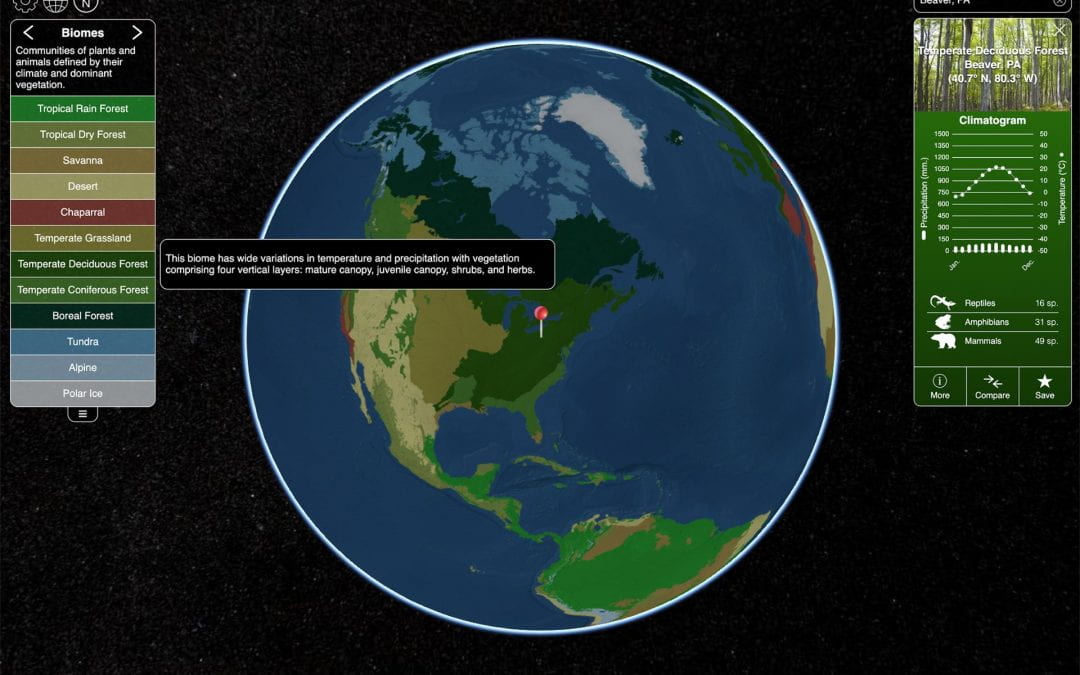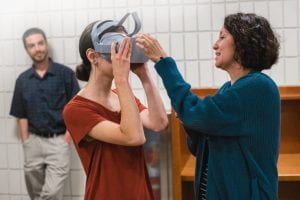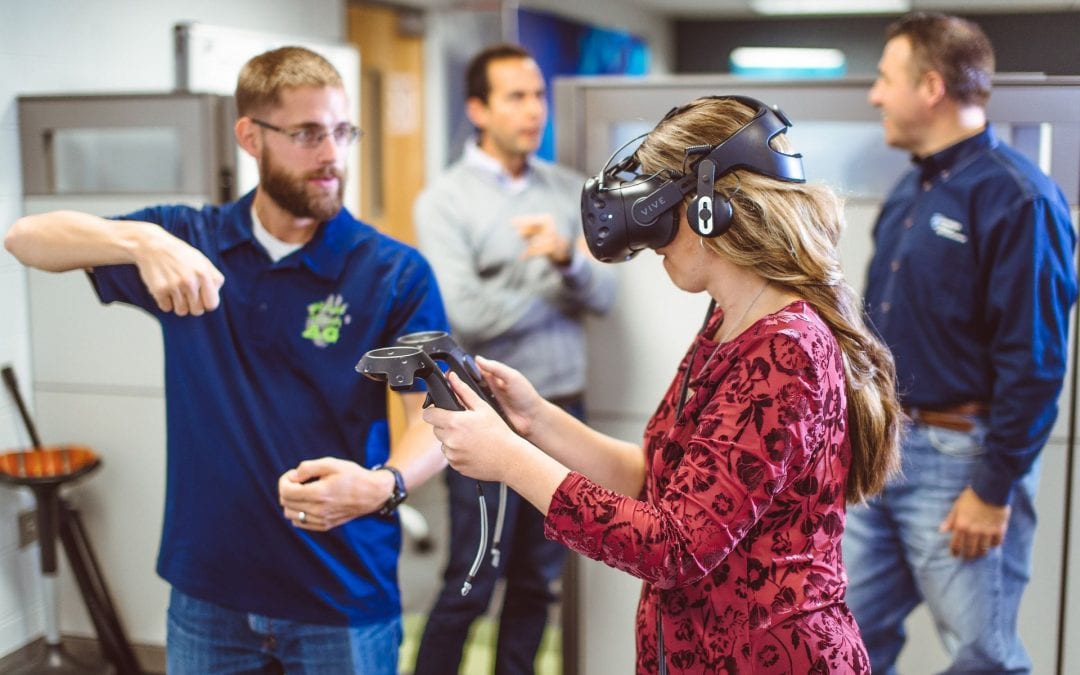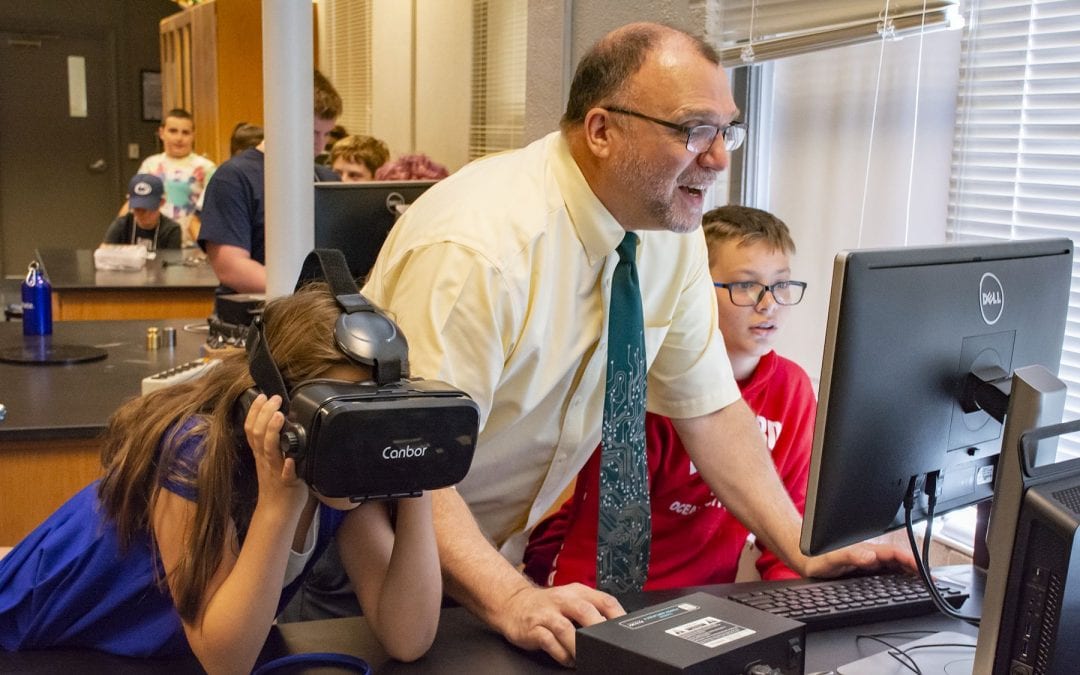
Campuses transform learning through immersive technology
As video technology becomes more prevalent as a method of conveying information to learners of all ages, faculty are integrating videos into their courses in an interactive way to engage students. Beyond just watching videos in a lecture, faculty are also incorporating virtual reality (VR) immersive experiences into the classroom that allow for active learning, drawing students’ attention to the critical points being taught in the course.
Working with faculty, staff, and students across Penn State, Media Commons is a University-wide initiative aimed to provide support and resources to incorporate digital media projects into the classroom. Media Commons is a Penn State Teaching and Learning with Technology (TLT) service that creates and maintains innovative learning facilities, as well as empowering students to become media-creators.
Students across Penn State’s campuses – from Penn State Beaver to New Kensington, and Shenango – are trailblazing the future of education with immersive technology in and outside of the classroom.
“Media Commons has always focused on the intersection of multimedia-based creativity and the classroom,” said Nick Smerker of Media Commons. “By leveraging our years of experience supporting students and faculty in their sharing of compelling stories, we aim to bring this focus on storytelling into a whole new realm of expressive tech.”

During a Media Commons showcase centered around a newly installed immersive experiences (IMEX) viewing pod, Penn State New Kensington students and faculty consulted with Media Commons staff to explore 360-degree cameras and virtual reality headsets. Yesenia Figueroa-Lifschitz, library assistant (right), helps sophomore Olivia Ahr try on a headset.
Last spring, an immersive experience (IMEX) viewing pod was installed at Penn State New Kensington. The new space is equipped with the same furniture used in the IMEX Lab at University Park. The ergonomic chairs are specifically designed to support a 360-degree range of body movement, allowing visitors to fully engage in a virtual reality environment.
Penn State New Kensington’s viewing pod has been used in a variety of ways, from an immersive art exhibit to the virtual exploration of South Korea, the 2019-20 pick for the campus’ Country of Focus study program. The viewing pod is open Monday-Thursday 8 a.m.- 8 p.m., Friday 8 a.m.- 5 p.m. for students to explore immersive technologies. To learn more or to reserve the pod, visit the Penn State New Kensington location page.
At Penn State Beaver, students in BIOL 220W (GN) Populations and Communities are connecting their learning material to the real world through 360-degree videos and interactive in-class activities. Cassandra Miller-Butterworth, associate professor of biology at the Beaver campus, has been teaching Populations and Communities for many years. Until this past spring, she would spend the first two weeks of class reviewing different biomes through a series of photos. “Most of my students were not engaged during this section of the course because I would describe a biome, and then show a photo of it. My goal was to try to make it more interesting and interactive to help students retain that information better,” says Miller-Butterworth.
With the help of Smerker, Miller-Butterworth was able to give her students an interactive in-class activity that depicts the twelve terrestrial and six marine biomes. Navigating through an interactive BiomeViewer map, students discovered different biomes with descriptions of its distinguishing features as well as search specific locations on the globe to explore additional information on climate, plant life, and animal species.
Smerker also helped Miller-Butterworth find and upload 360-degree immersive videos of the biomes to the Penn State IMEX Lab’s Experience Catalogue, an evolving list of 360-degree videos and virtual reality apps of varied disciplines, curated by the Media Commons team to engage students through the use of immersive content.
Miller-Butterworth’s students were able to launch a 360-degree video of a biome directly on their phones by clicking on a link to the content in the Experience Catalogue, which corresponded to the respective biome on the interactive map. Students then inserted their phones into a VR headset, allowing them to immerse themselves in the selected biome.
Sophomore Heaven Bowman enjoyed the immersive videos, which expanded her enthusiasm in the subject. “I loved how the technology enabled me to have such a hands-on experience in the classroom. I completely felt like I was in the rainforest and the desert, so it allowed me to understand more of the ecological aspects of the biome. It was engaging and made me want to experience more.”
Miller-Butterworth says anything that brings abstract concepts to life for students is essential. She points to this generation’s affinity for technology and watching videos, especially on their phones. “If you can bring those [technology] skills they already have and things they enjoy doing into the classroom, that helps them stay engaged and retain more information than a traditional lecture.”
The use of 360-degree videos of biomes in the classroom was first explored by 2018 TLT Faculty Fellow and associate teaching professor of biology, Karen Kackley-Dutt, to provide students the opportunity to observe Earth’s biomes for themselves through an immersive experience.
At Penn State Shenango, assistant teaching professor of nursing Maureen Dunn has also been very successful in implementing immersive reality approaches from her time in the 2018-19 Blended Learning Transformation (BlendLT) cohort, a program supported by TLT.
Dunn’s NURS 417 Family and Community Health Concepts, taught in spring 2019, was transformed from a fully face-to-face course to a blended environment. Teaching with immersive reality is appealing to Dunn because her students are adult learners. Most have full-time nursing jobs, often with long shifts, and families, which make it difficult to attend class. Her students appreciate the flexibility to complete assignments at home or at a time that fits with their schedule.
One assignment that posed a challenge for nursing students was a windshield survey. During the windshield survey, students were asked to go into the community to identify both the benefits and challenges in health education and local services.
Working alongside TLT staff, Dunn recorded eight different 360-degree videos that her students could view anywhere on their phones to complete the windshield survey. Students watched these videos, used Adobe Premiere to make edits, and through VR headsets, they learned more about what community health resources were available for individuals.
Smerker is enthusiastic about the 360-degree videos and their use in this type of course going forward. “Students benefit from being able to make informed decisions about how they tell the stories that matter to them. Whether as producers or consumers of immersive content, this fluency in technology-aided storytelling will be invaluable in sharing information in the years ahead.”
Instructors interested in starting to explore immersive reality in the classroom can explore the IMEX Lab’s Experience Catalogue’s digital resources. Media Commons also provides interactive workshops to teach students how to use iMovie and 360-degree video equipment to create immersive reality videos.

